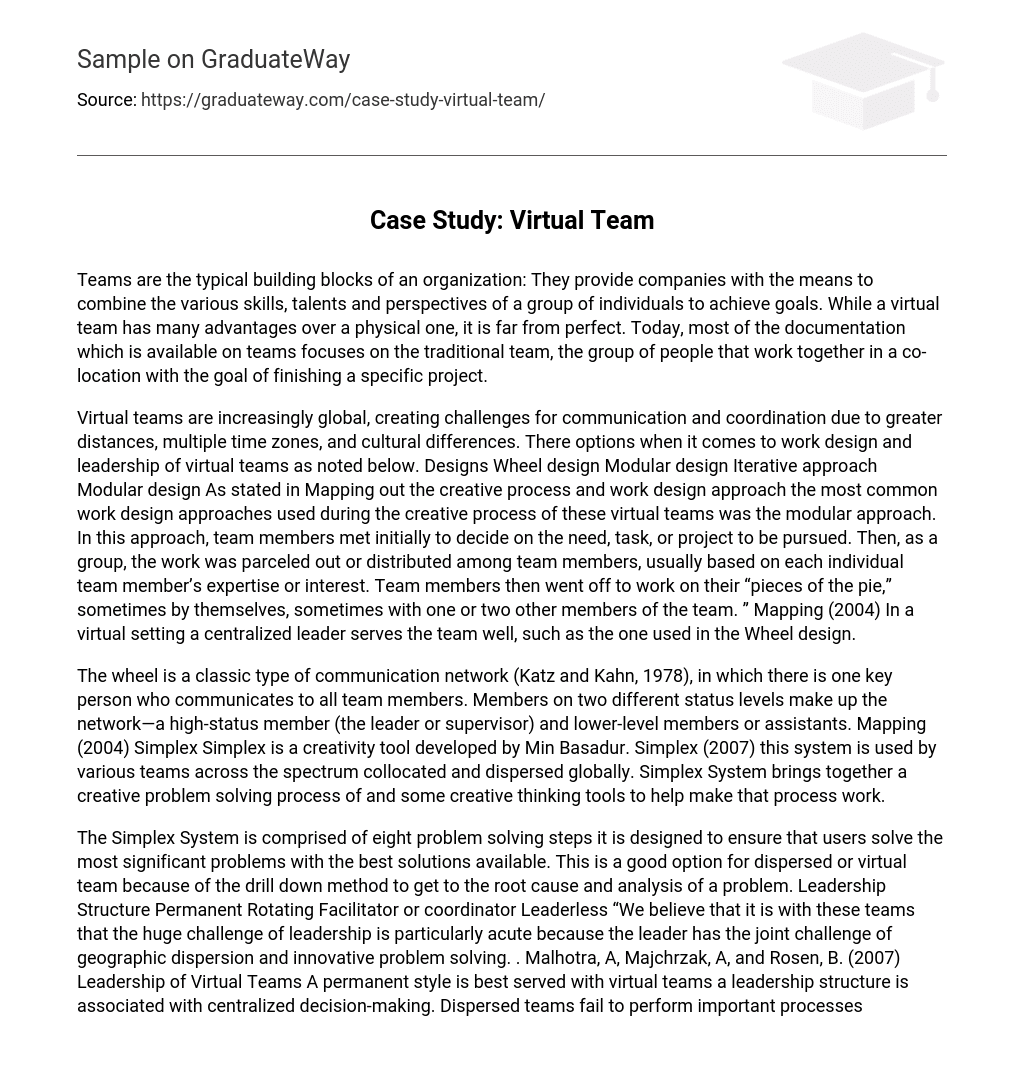Even though virtual teams have many advantages over physical teams, they are not without flaws. Most of the available documentation on teams primarily focuses on traditional teams, which consist of individuals working together in the same location to complete a specific project.
Virtual teams face challenges in communication and coordination due to distance, time zones, and cultural differences. Work design and leadership options for virtual teams include the wheel design, modular design, and iterative approach. Mapping out the creative process and work design approach highlights the modular approach as the most common, where team members meet to determine the task or project and then distribute the work based on expertise or interest. In a virtual setting, a centralized leader, such as the one used in the wheel design, is effective for the team.
The wheel is a classic type of communication network, where there is one key person who communicates to all team members (Katz and Kahn, 1978). The network consists of members at two different status levels – a high-status member (the leader or supervisor) and lower-level members or assistants. According to Mapping (2004), Simplex is a creativity tool developed by Min Basadur. Simplex (2007) reveals that this system is used by various teams across the spectrum, whether collocated or dispersed globally. The Simplex System brings together a creative problem-solving process and some creative thinking tools to help make that process work.
The Simplex System is comprised of eight problem solving steps. It is designed to ensure that users solve the most significant problems with the best solutions available. This is a good option for dispersed or virtual teams because of the drill down method to get to the root cause and analysis of a problem.
Leadership Structure:
- Permanent Rotating Facilitator or coordinator
- Leaderless
“We believe that it is with these teams that the huge challenge of leadership is particularly acute because the leader has the joint challenge of geographic dispersion and innovative problem solving.” (Malhotra, A, Majchrzak, A, and Rosen, B. 2007)
A permanent style is best served with virtual teams, and a leadership structure is associated with centralized decision-making. Dispersed teams fail to perform important processes effectively and are therefore unable to realize their potential. But given the fact that virtual teams have become an increasing reality for many companies, managers need to understand how to maximize the benefits of dispersion while minimizing its disadvantages.
Without effective leadership, virtual teams can quickly become chaotic. To ensure productivity, a leader must bridge the interpersonal and geographical gaps, fostering unity among team members with a shared objective. The primary obstacle faced by virtual leaders is the absence of cohesion among employees, resulting in poor collaboration and a loss of focus on team goals. While technology plays a role, it is but a small part of virtual leadership. Building strong relationships and trust are paramount in this context.
Below are several essential questions for a leader to answer in order to determine if the leader will be successful at leading a virtual team: Can I trust people I have never met face to face? Can they trust me? Would I be able to motivate and empower people over a mobile device? How would I facilitate ongoing opportunities for leadership development?
“Several of the teams we studied struggled initially because they lacked a common set of procedures or way of doing things. In the absence of communication norms, team members resorted to using the practices prevalent in their local setting.” (Malhotra, A, Majchrzak, A, and Rosen, B., 2007)
Virtual leadership is in many ways a paramount task that demonstrates the effectiveness of a leader. Empowering a group of people who are in the room with you can be difficult. Leading people who work from home is a challenge. Leading a group of people who are located in different countries, have different time zones, and speak different languages is extremely complex. One of the key reasons for organizing a dispersed team is to draw on the superior knowledge that resides in remote locations.
Collaboration is more challenging when working remotely compared to being in the same location. It can lead to issues such as communication and coordination difficulties, decreased trust, and a greater difficulty in establishing shared understanding. In a co-located team, a leader can quickly identify any teamwork issues and address them through direct management. In contrast, a virtual team leader must actively identify and address any shortcomings. Effective virtual leadership relies heavily on the use of current and evolving technologies.
However, the focus of leadership and teamwork should not be on technology and gadgets, but rather on building relationships among people (Malhotra, Majchrzak, & Rosen, 2007). It is important for leaders to prioritize creating relationships with their employees. The creative process and work design approach can help in mapping out these relationships (Malhotra et al., 2007). Additionally, the Simplex problem-solving process is a powerful tool that can be utilized in building these relationships (Mind Tools, 2007).





